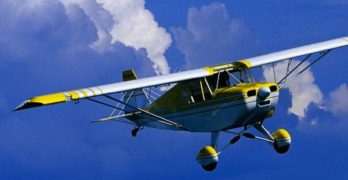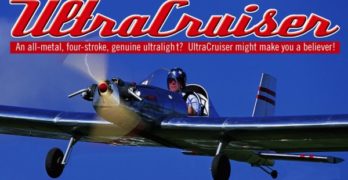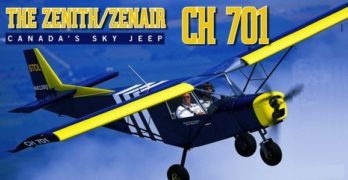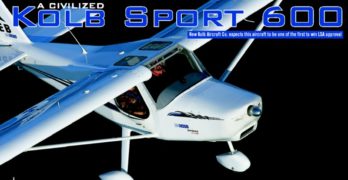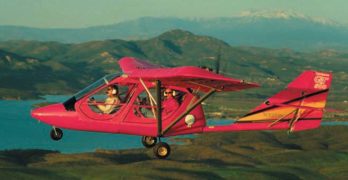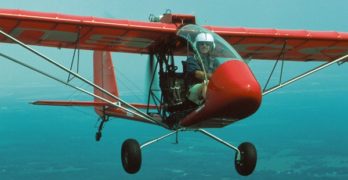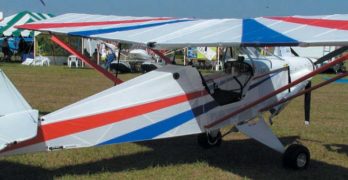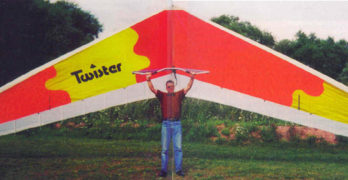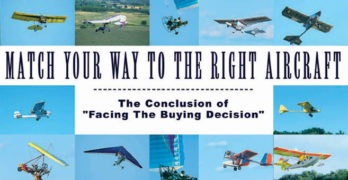Not all Light-Sport Aircraft will be composite.
Beautiful imported aircraft like the CT2K, Mirage, Jabiru, or Kolb Sport seem to best represent what many pilots imagine when they hear the words “light-sport aircraft.” These shapely composite designs are speedy and modern looking. Yet we’d be foolish to ignore the entire fleet of amateur-built light-sport aircraft (LSA) candidates. One of these is Fisher Flying Products’ Dakota Hawk.
Wood Still Works!
The Dakota Hawk is a simple, wood-structure light aircraft covered in fabric. Sound familiar? Sound comfortable and well understood? You bet it does.
While the Dakota Hawk may not be seen as a “modern” design, neither is it a vintage aircraft like Fisher’s fascinating Tiger Moth replica. Instead, most pilots probably link the Dakota Hawk to a golden era of general aviation when Piper Cubs, Taylorcrafts, and Luscombes were the darlings of light flight.
Regardless of what regulatory program it operates under, this high-wing taildragger is a sweet flier that will address what many pilots want out of aviation.
Search Results for : flight design ct
Not finding exactly what you expected? Try our advanced search option.
Select a manufacturer to go straight to all our content about that manufacturer.
Select an aircraft model to go straight to all our content about that model.
All-metal, Four-stroke, Genuine Ultralight
The new light-sport aircraft (LSA) category will soon be a reality. While a best guess is that FAA’s newest rules could be announced at EAA AirVenture Oshkosh later this month, it may happen later in the year. Whenever it happens, and like many others watching closely, I hope this new concept arrives swiftly with its promise of interesting aircraft at affordable prices.
As important as LSA may be, however, the proposed new the rule doesn’t affect other enjoyable flying machines. Aircraft built under the amateur-built (51-percent) rule will continue to be a major factor. Many EAA members are building under this rule, and these aircraft will continue to offer wide choices, performance beyond that of many general aviation aircraft, and the pride of craftsmanship. LSA also leaves room for Part 103 ultralights to continue and grow. While some industry leaders see little demand for single-seat aircraft powered by small engines-and it is true that they do not make up a majority of machines-neither, however, will they disappear.
Canada’s Sky Jeep
Pilots will go to great lengths to fly airplanes they like. I went to the Czech Republic to fly the CH 701. That’ s a long way, and I did like the airplane. The experience tells a story of light-sport aircraft development that may become increasingly common.
Like most light plane pilots, I’ve long been familiar with the designs of Swiss-born engineer Chris Heintz. His many aircraft models have put some 2,000 builders in the air. The low-wing, Piper Cherokee-like CH 601 is far and away the most popular air plane he’s designed, with it representing more than 60 percent of all Zenith models sold. Yet, perhaps the most distinctive-looking design he’s offered is the short takeoff and landing (STOL) capable CH 701, the subject of our discussion this month. Now the world grows smaller with Heintz’s Canadian designs being manufactured in the Czech Republic and freighted to the United States for fun in the sky.
Simple Done Right
AirBorne’s Outback trike has all the essentials
Light-sport aircraft (LSA) are on the minds of many would-be sport pilots, especially now that the proposed rule has advanced from the Depart-ment of Transportation (DOT) to the Office of Management and Budget (OMB) for its last review. But the big-picture view of these airplanes is complex. Yes, we’ll have sleek im-ported machines like the CT2K, G3 Mirage, SkyBoy, or SportStar, but we’ll also have much more. We will also still have popular American-made machines like Zenith’s CH 601, SkyStar’s Kitfox, Quicksilver’s MX or GT series, RANS’ Coyotes, Quad City Ultralight’s Challenger, and more. And we’ll have trikes, powered para-chutes, gliders, airships, gyros, and who-knows-what-else. The new LSA category actually represents a virtual zoo of different aerial animals. The fiberglass or metal versions that may enter our market from Europe are but the upper end of the spectrum, in both speed and price.
Trikes, in particular, may be one of the earlier qualifying entries.
A Civilized Kolb Sport 600
My first thought when I exited the Kolb Sport 600 after flying it was, “This is a very civilized aircraft.” Is that typical of what we can expect when light-sport aircraft (LSA) become the law of the land? I sure hope so|though I also hope Part 103 ultralights and kit aircraft continue to enjoy a solid share of the overall market.
With its sleek composite exterior, all-metal wing, custom interior, international (Canadian) design heritage, and cross-country performance, the Sport 600 from New Kolb Aircraft sets a pace others may hope to follow.
My test airplane for this month’s article was the personal property of New Kolb Aircraft owner Bruce Chesnut. That explains the gorgeous interior finished by a professional in Alabama: Leather-covered seats and fittings, tasteful embroidery, and beautifully formed and finished plastic covers graced the aircraft. Bruce’s Sport 600 also had attitude (IFR, or instrument flight rules) instruments, which is rare in the ultralights or kit-built aircraft I typically review.
Light Sport Aircraft Specifications
How do we evaluate light-sport aircraft?
The FAA’s proposed SportPlanes™ /light-sport aircraft (LSA) rule is being discussed in hangars across America. But it is also being discussed at airports all over Europe—more than you may think. The global reach of this initiative is visible by the large number of European suppliers aiming their sights on the huge U.S. market. Many believe they have an aircraft that fits the standard.
In the previous issue of KITPLANES®, you read Brian E. Clark’s summary of how European aircraft manufacturers are responding to LSA. In this issue, you can look at Barnaby Wainfan’s analysis of the aerodynamics of aircraft that meet the standard.
In concert, this column attempts to add information about LSA candidate aircraft that are flying now. I’ve had the pleasure to fly many of the aircraft that may one day call themselves LSAs. In that flying, I’ve learned some lessons about what you might expect and how to evaluate what interests you.
Ultralight Trainer from RANS
“RANS is back!”
said many ultralight enthusiasts when the company offered their production version of the S-17 Stinger in September, 1999. Now the Kansas company has reaffirmed their commitment to the ultralight community by offering an enlarged S-17 with an added, tandem seat. Welcome to the S-18 Stinger II.
Of course this isn’t the first ultralight trainer from RANS. They continue to sell their S-12XL Airaile 2-seater. Others may observe that the S-6 Coyote 2-place can be built to operate within the limits of the Part 103 training exemption.
But when RANS first talked about their single-place Stinger – the prototype model that was never marketed – the company had been going in another direction. In those days the apparent darling of the company was the S-16 Shekari that is more accurately described as competition for Van’s RV series than as an ultralight. RANS president Randy Schlitter was able to see that ultralights didn’t simply grow up and become “light aircraft.” And, since Schlitter wants a share of the ultralight community, the S-17 single-place Stinger was his 1999 entry to entice ultralight flyers to the RANS brand name.
New Ultralights at Sun ‘n Fun
New ultralights and light aircraft were featured at Sun ‘n Fun
As flying season begins, Florida’s popular Sun ’n Fun airshow brings a focus on new aircraft of all types. Aviation writers review the new machines revealed at the event. Yet many machines are often overlooked in the rush to place the most attention-getting aircraft onto magazine covers and into survey articles. This month, we cover a few ultralights and light aircraft you should find interesting.
While aircraft like Titan’s T-51 Mustang, Just Aircraft’s Escapade, Airborne’s XT and Sabre’s Wildcat garnered lots of attention, designers of other ultralights have also been working hard.
Ramphos
One machine no one had seen before was the Ramphos amphibious trike. Though the amphibious trike concept has been used by numerous other companies, the Ramphos has features the others have lacked such as its counter-rotating propeller.
A prior model required a small vertical tail and distinguished itself by a composite hoop surrounding the propeller arc.
Bautek Twister
When most Americans think of a large foreign glider manufacturer, they may be quick to name Moyes, Airwave, Aeros or even La Mouette. But most would fail to mention Bautek, Germany’s main manufacturer. This oversight may be understandable since Bautek has spent little effort marketing in the U.S. They have been content to serve the large European market which has historically been of greater volume than we could claim, despite our larger population.
All that is changing. Bautek has a new competitive topless glider aptly named (as we shall see) the Twister. Its performance is good and some special engineering renders it most desirable in terms of safety. In addition, the strong dollar in relation to European currency makes the price attractive enough to interest those pilots looking for a top performing, safe topless glider.
I took delivery of the Twister at Monte Cucco, Italy where I flew it in the Pre-World meet.
How-to-Buy a Lightplane — Part 3 of 3
In the previous two installments, we’ve discussed you, the pilot, and the many types of aircraft choices you have. As we wrap up this series, we’ll put it all together and try to help you narrow your choices to a few models.
Notice the word “try.” It is important that you understand that it is not possible to direct you to the one-and-only best choice of aircraft. Novice buyers often seek assistance but even experienced pilots can become swayed and end up purchasing the wrong aircraft for their needs and desires. Because aircraft purchases are commonly emotional decisions, it is helpful to gain a “second opinion” to help make a more rational choice.
Many years ago, at the beginning of my career writing articles in light aviation, I made a similar attempt to help hang glider pilots choose the right glider. I compared nine contemporary models to an idealized “perfect” glider and through a series of questions much like those below, tried to steer pilots to the one right glider for them.
- « Previous Page
- 1
- …
- 131
- 132
- 133
- 134
- 135
- …
- 145
- Next Page »


